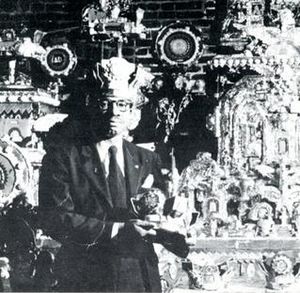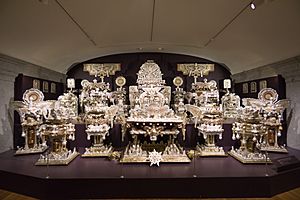James Hampton (artist) facts for kids
Quick facts for kids
James Hampton
|
|
|---|---|
 |
|
| Born | April 8, 1909 Elloree, South Carolina, U.S.
|
| Died | November 4, 1964 (aged 55) Washington, D.C., U.S.
|
| Resting place | Warren Chapel Baptist Church, Elloree, South Carolina |
| Nationality | American |
| Known for | Throne of the Third Heaven of the Nation's Millennium General Assembly |
| Style | Outsider art |
James Hampton (born April 8, 1909 – died November 4, 1964) was an American artist. He is famous for creating a large religious artwork called the Throne of the Third Heaven of the Nations' Millennium General Assembly.
Hampton worked as a janitor and secretly built this amazing art piece. He used many different materials he found, like old furniture and aluminum foil. The artwork is often called simply the Throne. Today, you can see it at the Smithsonian American Art Museum in Washington, D.C. A famous art critic, Robert Hughes, once said the Throne might be "the finest work of visionary religious art produced by an American."
Contents
Early Life of James Hampton
James Hampton was born in 1909 in Elloree, South Carolina. He was one of four children. His father was a gospel singer and a traveling Baptist preacher.
In 1928, Hampton moved to Washington, D.C. He lived there with his older brother, Lee. Hampton worked as a cook for a while.
Hampton's Military Service
In 1943, Hampton joined the United States Army Air Forces. He served in places like Texas, Hawaii, and the jungles of Saipan and Guam. His unit was not involved in fighting. Their jobs included carpentry and maintaining airstrips.
During his time in Guam, Hampton built a small, shrine-like object. He later added this piece to his much larger artwork. He received the Bronze Star award. In 1945, he was honorably discharged from the military.
After the war, Hampton returned to Washington, D.C. In 1946, he started working as a janitor for the General Services Administration. He kept this job until he passed away.
The Throne of the Third Heaven Artwork
In 1950, James Hampton rented a garage in Washington, D.C. For the next 14 years, he worked secretly inside this garage. He built a complex religious artwork using many different materials he found.
He used things like aluminum and gold foil, old furniture, and pieces of cardboard. He also used light bulbs, jelly jars, and broken pieces of mirror. He held everything together with tacks, glue, pins, and tape.
What the Throne Looks Like
The complete artwork has 180 different objects. Many of them have quotes from the Book of Revelation written on them. The main part of the artwork is a seven-foot-tall throne. It was built on an old armchair with maroon cushions. The words "Fear Not" are written at the top of the throne.
Around the throne, there are many altars, crowns, and pulpits. Some plaques on the left side have the names of apostles. Plaques on the right list important biblical figures like Abraham and Ezekiel. Hampton wrote the full title of his work, The Throne of the Third Heaven of the Nations' Millennium General Assembly, on the objects.
Meaning Behind the Throne
Hampton said his artwork was a monument to Jesus in Washington. He created it because he had several religious visions. These visions told him to get ready for Christ's return to Earth.
Hampton wrote that God often visited him. He also believed that Moses appeared to him in 1931. He said the Virgin Mary appeared in 1946, and Adam appeared in 1949. The term "third heaven" comes from religious texts that describe it as God's special realm.
The artwork is based on biblical stories about the future. This includes St. John's vision of God on a silver and gold throne with angels. It also refers to Judgment Day and crowns for those who are saved. The artwork also connects to African-American traditions and altars used in some New World religions.
St. James: The Book of the 7 Dispensation
James Hampton also kept a 108-page notebook. It was titled St James: The Book of the 7 Dispensation. Most of the writing in this book is in a secret script that no one has been able to understand yet. This text is available online and people are still studying it.
In his notebook, Hampton changed the idea of the "seventh dispensation." He saw himself as the author of this book and a special guide for the future. Hampton wrote down "the Old and the New Covenant." He also wrote a second set of commandments. He believed God gave these to him because people were no longer following the original Ten Commandments.
Some parts of the notebook had notes in English written by Hampton. In these notes, Hampton called himself "St. James." He also used the title "Director, Special Projects for the State of Eternity." He ended every page with the word "Revelation."
Hampton also wrote other texts on paper and cardboard. He had a quote from Proverbs 29 tacked to a bulletin board in his garage. It said, "Where there is no vision, the people perish."
He also made wall plaques with Roman numerals from one to ten. These plaques had his secret script, like commandment tablets. The largest plaque said "Nations Readjustment Plan" and was decorated with gold foil.
Hampton tried to get local churches to use his artwork for teaching. But no churches were interested. Two reporters saw the display but did not think it was important enough for the news. Hampton hoped to open a religious storefront, but he never did.
Hampton was a private person. He did not have many close friends. He spent most of his free time working on his artwork. He went to different churches in Washington but never joined one. He believed that having many different church groups went against the idea of one God. He also wanted to find a "holy woman" to help him with his life's work, but he never got married.
It is not known if Hampton thought of himself as an artist. His work is an example of outsider art or naïve art. This is art made by people who teach themselves and have not studied art in school.
Discovery of the Artwork
James Hampton died from stomach cancer on November 4, 1964. He passed away at the Veteran's Hospital in Washington. He is buried in South Carolina.
His amazing artwork was not found until after he died. The owner of the garage, Meyer Wertlieb, went to check on the garage because Hampton had not paid the rent. He knew Hampton had been building something inside. When he opened the door, he found the room filled with the artwork.
Hampton had kept his project a secret from most of his friends and family. His relatives first heard about it when his sister came to claim his body. When Hampton's sister did not want the artwork, the landlord put an advertisement in local newspapers.
A sculptor named Ed Kelly saw the ad. He was so amazed by the artwork that he contacted an art collector named Alice Denney. Denney brought other art experts to see the display in the garage. Harry Lowe, who worked at the Smithsonian Art Museum, said that walking into the garage "was like opening Tut's tomb."
The story of James Hampton and his artwork became public in the Washington Post newspaper on December 15, 1964. Harry Lowe paid Hampton's unpaid rent and took the artwork. In 1970, Hampton's work was given to the Smithsonian American Art Museum. It has been on display there ever since.
In Popular Culture
James Hampton's artwork has inspired many other artists and creators.
- Author and poet Denis Johnson published a book of poems. It was titled The Throne of the Third Heaven of the Nations Millennium General Assembly: Poems Collected and New.
- In 2007, composer Jefferson Friedman created a musical piece. It was inspired by Hampton's artwork and called "The Throne of the Third Heaven."
- The indie music group Le Loup named their first album in 2007 The Throne of the Third Heaven of the Nations' Millennium General Assembly.
- In 2015, author Shelley Pearsall wrote a young adult novel. It was called The Seventh Most Important Thing. This book imagined a meeting between Hampton and a troubled teenager. The author said she was inspired by Hampton working alone for years to create art just for art's sake.
- In 2018, author Tommy Orange wrote a short story called "The State." This story mentioned Hampton and his artwork. It was also a chapter from Orange’s 2018 novel There There.
See also
 In Spanish: James Hampton para niños
In Spanish: James Hampton para niños


